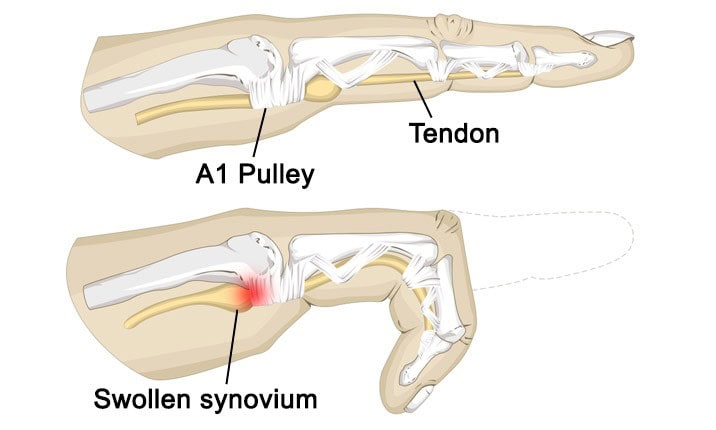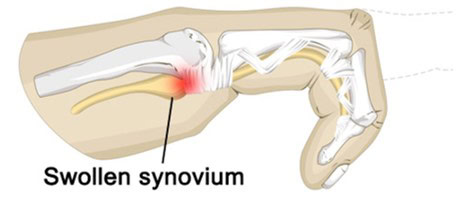What is a trigger finger?
Trigger finger, a type of stenosing tenosynovitis, is a condition in which your fingers catch or lock when you bend them, causing them to get stuck in a bent position. It can affect more than one finger at a time, and when the thumb is affected, it is called trigger thumb.
Symptoms of trigger finger include:
How does a trigger finger occur?

The flexor tendon of your finger, which connects forearm muscles to your finger bones, passes through structures known as pulleys.
In a trigger finger, inflammation causes the region of the A1 pulley to narrow, resulting in pain and a catching sensation as the tendon glides through it (the A1 pulley). In the early stages, it is still possible to straighten your finger, which gives way with a sudden snap.

Inflammation may occur due to:
How does a trigger finger affect my daily life?
Symptoms of trigger finger may render you unable to effectively perform daily activities that require the use of your fingers, such as:
Thus, if you find your trigger finger affecting your ability to perform everyday tasks, you should start to explore treatment options. Delaying treatment will cause you further pain and inconvenience.
How is a trigger finger diagnosed?
Clinical evaluation is often enough to diagnose trigger finger. As triggering gets more severe, the finger may be locked in a fixed flexed position. Plain x-rays may sometimes be necessary to exclude other causes of a locked finger
What are the treatment options available for trigger finger?
Non-surgical
Initial treatment for a trigger finger is generally non-surgical.
Rest and Medications
Trigger finger is often caused by overuse/ repeated movement of your finger. The combination of anti-inflammatory pain medication, with rest may occasionally be sufficient to treat trigger finger.
You may wear a splint to immobilise your affected finger. Splintage enforces rest and can help to heal a trigger finger.
Injections
Steroid and local anaesthetic injections are commonly used to treat trigger fingers, and a single injection is successful in up to 70% of cases. The procedure is generally safe but carries a small risk of temporarily increased blood sugar levels and a small risk of infection involving the finger. Repeated treatments can be attempted if the initial injection fails to relieve symptoms completely.
Hand Therapy
A guided program of hand therapy exercises in combination with any of the above treatment methods can increase the success of non-surgical treatment of trigger fingers.]
Surgical
Surgery may be recommended if your symptoms are severe, or if non-surgical treatments have not worked for you. Surgery for the trigger finger involves the release of A1 pulley, allowing the tendons (some of which are inflamed and have developed nodules) to move through the pulley without getting stuck. If you have developed a nodule at the tendon, this will usually be excised at the time of surgery.
What is the recovery process like for a trigger finger?
Recovery after trigger release is usually uneventful. Stitches are often removed after 10 days, and patients are started on a course of hand therapy thereafter. Most patients will be able to return to full activities a month after surgery.
For an assessment of your condition, please book an appointment with Dr Yong Ren.